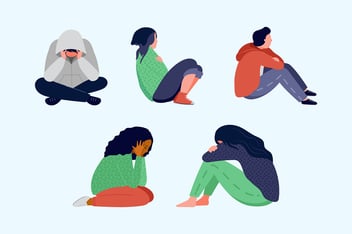Unveiling the Mental Health Implications of Cannabis Dependency

Understanding Cannabis Use Disorder (CUD) as a diagnostic term signifies problematic marijuana usage, introduced in the DSM-5. Previously, the DSM distinguished between cannabis abuse and dependence. Approximately 10% of the global cannabis user population is affected by CUD, acknowledging adverse impacts without necessarily indicating addiction. This piece explores CUD symptoms, diagnosis, causative factors, and available treatments.
Signs and Symptoms of Cannabis Use Disorder
In cannabis use disorder, it's crucial to recognize that the user experiences problems or issues as a result of their cannabis consumption. Meeting at least two of the specified criteria or symptoms within a 12-month timeframe signifies the presence of this disorder.
- Continuing to use cannabis despite physical or psychological problems
- Continuing to use cannabis despite social or relationship problems
- Craving cannabis
- Difficulty controlling or cutting down cannabis use
- Giving up or reducing other activities in favor of cannabis use
- Problems at work, school, and home as a result of cannabis use
- Spending a lot of time on cannabis use
- Taking cannabis in high-risk situations
- Taking more cannabis than was intended
- Tolerance to cannabis
- Withdrawal when discontinuing cannabis
Diagnosis of Cannabis Use Disorder
To diagnose cannabis use disorder, a healthcare provider examines the person's history, including substance abuse and mental health in their family, medical background, and exposure to stress. Lab tests can help identify cannabis use, but a positive result doesn't guarantee the disorder, nor does a negative result rule it out. It's important to consider reported cannabis intake against blood levels. Additionally, the severity of the person's issues is assessed.
- Mild: two to three symptoms
- Moderate: four to five symptoms
- Severe: six or more symptoms
The updated classification of cannabis use disorder, distinguishing it from dependence or abuse, allows for the diagnosis of severe cannabis use disorder without the presence of tolerance or withdrawal, typical signs of addiction. Conversely, individuals may meet criteria for mild cannabis use disorder despite exhibiting significant physical tolerance and withdrawal symptoms.
CUD and Other Mental Health Conditions
Diagnosing cannabis use disorder can be complicated when there are coexisting mental health conditions. For example, both major depression and generalized anxiety disorder are strongly linked to cannabis use disorder. Additionally, studies have indicated elevated rates of marijuana use disorder among individuals with post-traumatic stress disorder. Furthermore, research has highlighted associations between cannabis use disorder and various other substance use disorders.
- Sedative use disorder
- Cocaine use disorder
- Stimulant use disorder
- Club drug use disorder
- Alcohol use disorder
What are the physical effects of cannabis use disorder?
The effects of cannabis can differ based on individual reactions, the type of cannabis consumed, and the frequency of use. Physical symptoms may include persistent coughing, increased susceptibility to lung issues, elevated heart rate, and occasional severe nausea and vomiting. Prolonged and heavy cannabis use can also lead to changes in brain functioning and neural networks.
Causes of Cannabis Use Disorder
THC, or delta-9-tetrahydrocannabinol, is the compound in cannabis responsible for its psychoactive effects. It binds to cannabinoid receptors in the body, triggering the release of dopamine and activating the brain's reward system, potentially leading to addiction.
Substance use disorders, including cannabis use disorder, can have various contributing factors. Stress, emotional distress, and mental health conditions like anxiety and depression may all play a role in its development.
Treatment for Cannabis Use Disorder
Several treatment options are available for individuals with cannabis use disorder. Treating both the disorder and any co-occurring conditions simultaneously often yields the most positive outcomes.
Around 10% of daily cannabis users pursue treatment. Barriers to seeking treatment include low motivation, resistance to change, stigma, concurrent mental health issues, and limited access to care.
Counselling and Therapy
Effective counselling and therapy options for reducing cannabis use and related issues include:
- Cognitive behavioural therapy: Helps individuals recognise and modify negative thought patterns to positively influence behaviour.
- Motivational enhancement therapy: Encourages individuals to change harmful behaviours by enhancing motivation for change.
- Contingency management: Establishes goals and rewards or penalties through a formal contract to facilitate behavior change.
- Online interventions with chat counselling: Offer support for those with cannabis use disorder, particularly for individuals not accessing traditional outpatient treatment options.
Additionally, research underscores the significance of developing a strong sense of self-efficacy, predicting long-term abstinence from cannabis use.
Medication
Currently, the Food and Drug Administration (FDA) has not approved any medication for treating cannabis use disorder, although some are being researched. In the absence of approved medications, counseling and therapy remain the primary treatment approach for addressing cannabis use disorder.
In conclusion, cannabis use disorder is a complex and multifaceted condition that warrants attention and intervention. As society grapples with evolving attitudes and regulations surrounding cannabis use, it is imperative to recognize the potential risks associated with excessive or problematic consumption. By raising awareness about the signs and symptoms of CUD, promoting early detection and intervention, and expanding access to evidence-based treatments, we can work towards mitigating the negative impact of this disorder on individuals, families, and communities.
Moreover, fostering open dialogue and destigmatizing discussions around substance use and mental health can encourage those affected by CUD to seek help without fear or judgment. As research continues to deepen our understanding of the underlying mechanisms and effective interventions for CUD, it is essential to prioritize comprehensive approaches that address the biological, psychological, and social factors contributing to this disorder.
Through collaborative efforts between healthcare professionals, policymakers, educators, and community stakeholders, we can strive towards a future where individuals struggling with cannabis use disorder receive the support and resources they need to achieve lasting recovery and well-being.




